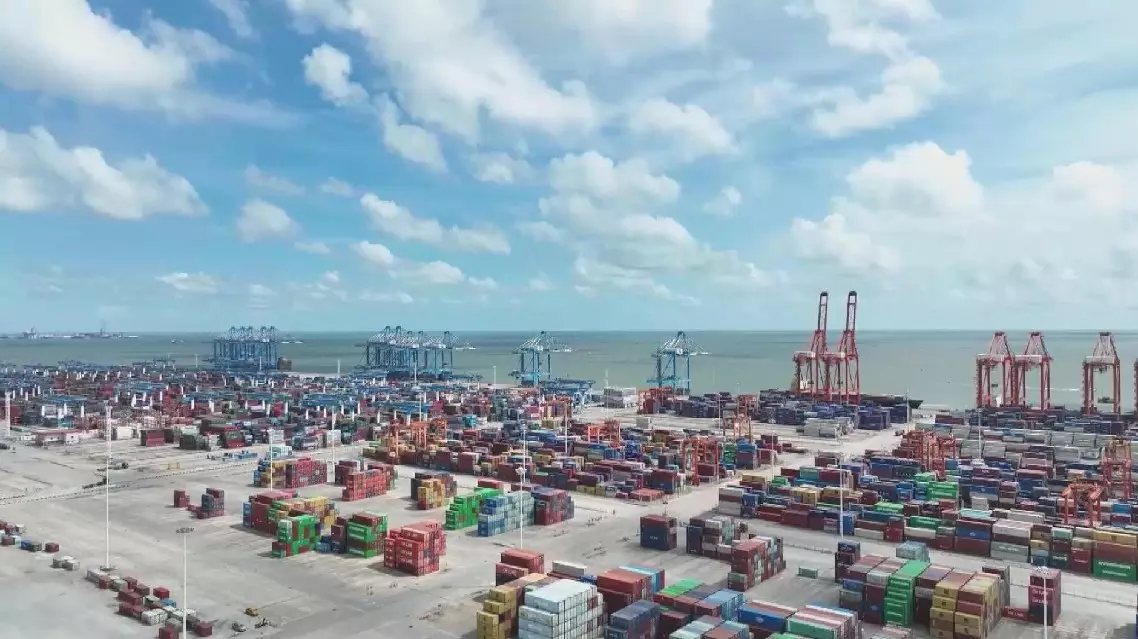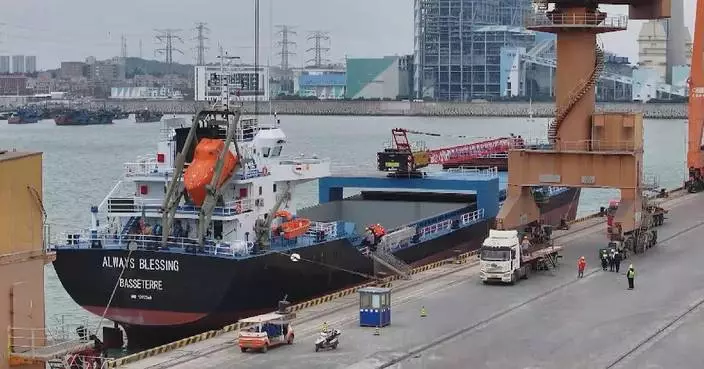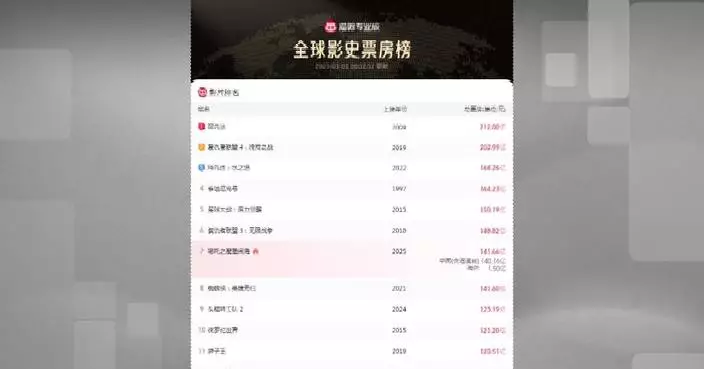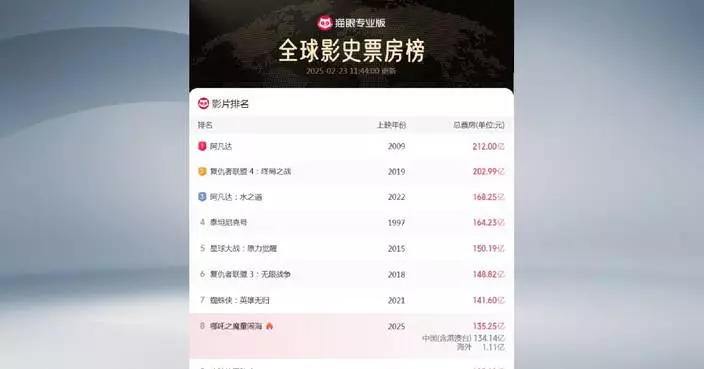Beibu Gulf Port in south China's Guangxi Zhuang Autonomous Region has innovated its operation system to improve shipment efficiency and facilitate transfer process between port and railway transportation systems.
A batch of lithium battery energy storage cabinets were recently loaded onto a Dutch ship at berth No. 2 of Dalanping south operation area of Qinzhou Port, a part of Beibu Gulf Port, which is the first time that Beibu Gulf has realized the bulk shipment of lithium battery energy storage cabinets for export.
Since the beginning of this year, Beibu Gulf Port has actively coordinated resources to resolve bottlenecks. In the loading and unloading operations, it endeavored to solve the problems of small loading volume of each container export shipment and difficulty in booking shipping space.
"Now the export of the 'new trio' (electric vehicles, lithium-ion batteries and photovoltaic products) from Beibu Gulf Port is growing rapidly, with large cargo volumes and high values, and some of the goods are included in the nine categories of dangerous goods. All these factors have put high requirements on the service capabilities of port enterprises," said Song Haitao, manager of Beibu Gulf Port Qinzhou Bonded Port Area Shenggang Terminal Co., Ltd.
Facilities, like bridge crane and rail cranes, and unmanned transport vehicles at the Beibu Gulf Port Qinzhou automated container terminal can be accessed with one click in its remote control room.
As the world's first automated terminal to adopt a U-shaped layout, the terminal has innovated operation mode to isolate container trucks from outside the port and unmanned transport vehicles in the port, which has improved the safety of different kinds of vehicles running at the terminal and the efficiency of container stacking.
Guangxi is connected to ASEAN countries by land and sea and has a natural port good for shipment, but it once faced with the embarrassment of shorter shipping distance but longer shipping time and higher costs due to poor operation.
While improving efficiency with technological innovation, Guangxi has conducted an in-depth mechanism reform in wider range, to stimulate the vitality of the sea-rail intermodal transportation of Beibu Gulf Port.
Guangxi issued several documents on the integrated construction and operation of Beibu Gulf Port sea-rail intermodal transportation in 2023, which has vigorously improved efficiency through measures such as spatial integration, policy coordination and information sharing.
The first step of operation was to remove the separation wall that had existed for many years between the railway center station and the port area and put the two units under the administration of the customs.
Along with physical segregation, data barriers between multiple departments were also removed to simplify the transfer process of sea-rail intermodal transportation.
"We used to have to go through two gates and made a detour of two kilometers to pick up containers. Now, after the gates were removed, we can save about 20 minutes," said Pang Daying, a driver of Qinzhou North Port Supply Chain Co., Ltd.
"Beibu Gulf Port was the first in China to achieve real-time connection between ports and railway stations, which has increased the container transfer efficiency between ports and railway by about 50 percent," said Song.
At present, the sea-rail intermodal train of the new western land-sea corridor have radiated more than 70 cities and over 150 railway stations in 18 domestic provinces, autonomous regions and municipalities, reaching more than 500 ports in over 120 countries and regions.
In the first half of this year, more than 276,000 TEUs of goods were shipped through Beibu Gulf Port on the new western land-sea corridor, up 22.4 percent.

Beibu Gulf Port streamlines procedures to achieve optimal transit efficiency
Deputies from China's Hong Kong Special Administrative Region (HKSAR) to the 14th National People's Congress (NPC) pledged on Friday to better leverage the SAR's strengths in technology, culture and education through innovation to support the country's modernization drive.
At the ongoing third session of the 14th NPC, China's national legislature, the Hong Kong delegation held a group meeting open to media to deliberate the government work report, which was unveiled on Wednesday at the NPC annual session.
The report stressed the importance of fully, faithfully and resolutely implementing the policy of "One Country, Two Systems", under which the people of Hong Kong administer Hong Kong with a high degree of autonomy.
The central government said it supports Hong Kong in growing its economy and improving the lives of its residents, ensuring that Hong Kong better integrate itself into China's overall development and maintain long-term prosperity and stability.
NPC deputies from Hong Kong said it shows the central government's care and support for Hong Kong while pointing the way forward for the region's development. They expressed readiness to make even greater contributions to national efforts in building China into a great country and achieving national rejuvenation.
Nancy Ip, president of the Hong Kong University of Science and Technology and an academician of the Chinese Academy of Sciences, highlighted Hong Kong's potential in scientific and technological innovation.
"Artificial intelligence (AI) is among the main focuses at this year's 'two sessions'. The rapid rise of Chinese companies such as DeepSeek demonstrates the country's competitiveness in the AI field. Hong Kong recently launched its first large language model, marking a significant step forward in this sector," said Ip.
"The government work report specifically calls for sustained efforts to advance the AI Plus initiative. We hope Hong Kong can continue to play a key role in international sci-tech cooperation and contribute to the nation's sci-tech innovation," she added.
Kenneth Fok Kai-kong, a member of the HKSAR Legislative Council, underscored Hong Kong's role in promoting Chinese culture globally, citing the box office success of the recently released animated blockbuster "Ne Zha 2".
"Ne Zha 2 has recently shattered box office records, breaking away from the Hollywood-dominated storytelling model and successfully captivating global audiences with Chinese narratives and philosophy. I think Hong Kong can further embrace the concept of 'culture plus' to make greater contributions to the cultural industry," said Fok.
"Building on its role as an international bridge and its traditional advantages, Hong Kong can serve as a 'financial hub' and 'export hub' for the Chinese cultural industry, facilitating collective expansion of Chinese cultural products into global markets and allowing cultural programs and industries to complement each other, " he said.
Ken Wong Kam-leung, chairman of the Hong Kong Federation of Education Workers, set his sights on educational reform and collaboration.
"In future, Hong Kong should improve its vocational education system to nurture more technical talents that meet the requirements of emerging industries, and promote collaboration between industries, universities, and research institutes to facilitate the application of sci-tech achievements. It should deepen research cooperation with mainland universities to create synergies and boost sci-tech innovation in the [Guangdong-Hong Kong-Macao] Greater Bay Area city cluster," he said.
"The education sector in Hong Kong must stay motivated, leverage its unique strengths, and steadfastly advance high-quality education development, contributing to Hong Kong's long-term prosperity and stability as well as the nation's modernization drive," said the NPC deputy.
The annual "two sessions," a key political event shaping the country's policy direction, refer to the annual meetings of the NPC and the National Committee of the Chinese People's Political Consultative Conference (CPPCC), the top political advisory body. The NPC session is taking place from March 5 to March 11 this year, while the CPPCC National Committee session runs from March 4 to March 10.

NPC deputies from Hong Kong vow to contribute to nation's modernization






















































